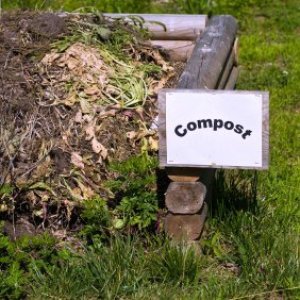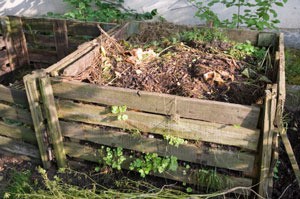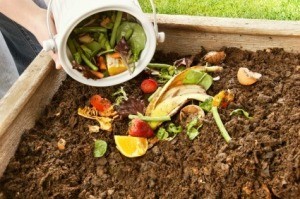
This page contains the following solutions.
 Composting is an easy, inexpensive way to reduce your yard and kitchen waste, while keeping your garden filled with nutrient-rich soil. Keep your compost pile neat and trouble-free, by preventing these common problems before they arise.
Composting is an easy, inexpensive way to reduce your yard and kitchen waste, while keeping your garden filled with nutrient-rich soil. Keep your compost pile neat and trouble-free, by preventing these common problems before they arise.
 Composting recycles organic matter into a nutrient-rich soil amendment. Although the finished product is a complex mixture of organic matter, bacteria and enzymes, the process of making compost isn't complex at all. It's just a great way to improve your soil while doing something useful with your kitchen and yard waste.
Composting recycles organic matter into a nutrient-rich soil amendment. Although the finished product is a complex mixture of organic matter, bacteria and enzymes, the process of making compost isn't complex at all. It's just a great way to improve your soil while doing something useful with your kitchen and yard waste.
Double or Triple Heap composting: The most popular way to compost is called Double (or Triple) Heap Composting. Also referred to as "cold" composting, it is a slow but practical method to produce compost and requires little effort on your part. Start by building one compost heap to which you gradually add kitchen scraps, weeds that haven't gone to seed, tree trimmings, and garden wastes until the heap stands 3 feet high. This may take several weeks. Each time you add new materials to the heap, turn it to mix and moisten the existing materials.
Quick fixes for "cold" compost: If your cold pile seems too slow, try these remedies to jump start the decomposition process:
"Cooking" the pile: Start by layering equal amounts of brown and green organic matter until you create a compost pile that is 3 feet tall and 3 feet wide (each layer should be 4 to 6 inches thick). Moisten the pile as you build it and allow it to sit for three days. Then use a pitchfork to turn and re-moisten the pile. As you turn it, try to move the material from the outside of the pile to the inside of the pile. Turn the pile again five days later. At this point you should feel heat radiating from the pile as you turn it. Wait one week and turn the pile again. After the third turning the temperature of the pile should be sufficient to create finished compost in another 4 to 6 weeks.
Directions for building simple compost bins
50% Brown Matter (carbon-rich, dry)Including:
30% Green Matter (nitrogen-rich, moist)Including:
10% Garden soil
5% water
5%high nitrogen fertilizer
Problem: The pile smells like sulfur.
Cause: A pile that smells like "rotten eggs" is either too wet, or lacks oxygen.
Solution: Aerate the pile by turning it over and letting it dry out a bit, and then add more dry materials.
Problem: The pile smells like ammonia.
Cause: This is usually due to fermenting food scraps lying on top of the pile.
Solution: Turn the pile and add additional carbon-rich (brown) material such as leaves.
Problem: The pile smells like sewage and is attracting flies.
Causes: This is most likely the result of too much nitrogen.
Solution: Turn the scraps to the center of pile, and cover them with a layer of garden soil or brown matter.
Our neighbors think we are very odd people when we save grass clippings, leaves, discarded fruit and veggie peels, and now shredded newspaper clippings.
What is Compost? Compost is the end result of the decomposition of organic material, or waste. This occurs naturally in the bush, or a forest, by the accumulation of debris from plant and animal material; and provided there is moisture present, decomposition will occur.
How do I make my own compost? Composting doesn't have to be complicated. There are really no hard and fast rules, but here are some tips for getting started. Find a convenient place near your garden to start a pile.
A layering method first devised by Sir Albert Howard in 1931 while he was doing studies in India.
Do you throw your Tim Hortons' cups in the recycle or garbage? I found out that they can be composted. So I rinse them out and place one at a time, inside my small compost container, and use them for soggy things like tea bags and coffee filters, oatmeal too.
Composting adds free organic material to your garden which helps the soil retain and drain water and encourages healthier plants. Here is an easy way to compost.
For maximum efficiency, the compost pile needs to consist of the right carbon/nitrogen (brown to green) ratio (between 25:1 to 30:1). If your bin is not completely enclosed on the bottom, use the following recipe...
Used in composting to stimulate biological activity. Because they are usually high in nitrogen, activators feed microorganisms; they might also contain other decay organisms that become introduced to the compost via the activator.
A quick and easy compost method if you don't have manure but do have a good supply of grass clippings. Grass is quite high in nitrogen. Mix one part of sawdust with four parts of fresh grass clippings.
During the winter I set a large trash can outside my kitchen door. I place my food scraps (compostable ones) in this during the winter. There is no smell as it rarely gets above freezing in Vermont during the winter.
Here are the questions asked by community members. Read on to see the answers provided by the ThriftyFun community.
I need some ideas to start an economical compost pile.
Hardiness Zone: 8a
By Joy Poulos from Slidell, LA
You can compost in a pile on the ground if you want to and you don't have pets or kiddos that will "get into it". As far as what goes into it, you don't have to spend any money really: peelings, leaves, etc.
You should have some sort of a can to put your items in to compose to keep critters out of it. All you need is to put vegetation matter in to the pile. No animal items such as meat,fat,milk etc. and the pile should be turned from time to time.
What the other two posters failed to mention is you want to turn your compost with dirt in it. You also should make it damp before you turn to get the moisture mixed into the compost. Don't soak it down though. Just make it damp.
I would suggest if you are not going to get something to turn your compost in that you get a couple buckets. Start your compost in one bucket till it is half full. Then dump the contents into another bucket sporadically with dirt. When the bucket is full set it aside till you have another half bucket. Now pour that bucket into a third bucket along with portions from the first bucket.
The bucket method is kind of difficult but do-able. What would be better is if you have a hole or a slight depression in the ground to pour and mix your dirt and compost materials. Make it damp and turn it as needed. Keep something heavy over the compost pile to prevent unwanted scavengers. My dad used to use his old bass boat and kept a tire on it to keep it in one place. Very few things would bother with it.
Check with your city waste services. Here in Phoenix, they take the big barrels used for trash pickup, when they are no longer usable for that, drill holes in them, remove the lids and sell them for a small amount ($10 the last time I bought them) and I think they also came with some kind of compost starter. Compost is black gold for the garden. Especially good in compost is coffee grounds as the worms love them and your soil loves the worms.
Pat
Even though your question and all these comments are about starting the pile, there is something I want to add to get a running start. Right this minute, start saving egg shells and all peels you make like from carrots, cukes, apples, celery etc. so they can be added to the pile once you start it. You can easily do this by taking an empty large coffee can, with a small hole punched into the plastic cover (for air), and having it right near the kitchen counter.
I started my compost by purchasing several bags of inexpensive dirt from Home Depot. I think they were on sale for about 3 bucks a bag. I have a Ninja blender that I use to chop up all the peelings, ends of zucchini and squash, apple cores, egg shells and etc. It's all chopped really fine and composts fast. The critters don't pay any attention to my compost pile cuz the pieces are so small they just disintergrate into good dirt.
The only thing I wanted for Christmas last year was a pitchfork with the wide straight tines so I could turn my compost pile more easily. I got one...all wrapped in Christmas paper and a big bow! I was a happy girl! (My friends thought I was nuts to ask for a pitchfork, but they just don't understand.......)
I also went to a local store that sells live worms for fishing bait and bought a container and set them free in my compost pile!! No harm in helping the worm population get started. *L* Beats the heck out of getting impaled on a hook!
If using table waste in the compost pile does it attract animals to feed from it? I am concerned that table waste will attract mice, rats, raccoons, etc. If so it seems that this would give the critters access to the vegetables in the garden as well.
I compost a lot at home and use all table waste with the exception of meat, fat or dairy. In fact, my family, kids and husband, all are now used to putting the "waste" into the compost container instead of the garbage disposal or trash can. I haven't had a problem with critters. Maybe because I always cover my table waste with a thick layer of soil or compost that has ripened. If it's covered well, critters will usually not bother. Hope this helps!
I've never had any problems with critters or creatures disturbing my compost and I use all kinds of kitchen food scraps. I never compost meat or bones.
Just be sure to cover each new addition of table scraps with the other composted materials or some dirt. That ensures that there won't be any odor.
My compost bin is located not far from my back door and I've never had any problems with odors or critters.
Good luck with your composting efforts! It's very worthwhile and makes a fantasticly rich addition to veggie garden soil.
If you are really worried about "critters" take a storage bin (any size - from W-M or home store)and poke some holes around the bottom, sides, and top and use it for your compost. Just turn the thing over (and side to side) often. I have a wire cage I use and have never had critters bother it. Can't convince my husband though!
I've composted for several years and have had no problem...I compost egg shells, coffee grounds, veg peelings, even some cooked veges, peanut shells, weeds, leaves, grass clippings, etc...but I do not compost anything that is meat, fats, bones, or animal poo...I make a thin layer of scraps and cover it with a layer of shredded newspaper, junk mail, etc...I mix it in some too.....I keep a paper shredder in our back garage so it is handy....you need a mix of greens/wet stuff (weeds, vege scraps, grass clippings) along with dry/browns (leaves, shredded paper)..and they need to be mixed some...I put the layer of shredded newspaper on and leave it till I start to put in greens again...then I mix it, put in the greens and cover it with shredded newspaper or dry leaves again....
My dad, who lives in a subdivision, has a terrible problem with rats, racoons, etc. invading his compost pile. And they are NOT SHY either. He put out traps and rat poison
Thanks to all who responded to my concern. It seems that if done right critter problems are few. I will give it a go and see how things turn out. Thank you everyone.
How do I set up an organic compost bin?
Hardiness Zone: 4b
By c henderson from Grand Lake, CO
ThriftyFun is one of the longest running frugal living communities on the Internet. These are archives of older discussions.
Can anyone tell us what do you use to start a compost bed? We are trying to start a compost but are not sure what to put in it. Thanks in advance for all your help.
Hardiness Zone: 9a
By Karen
Use any organic product. That means veggies, leaves, grass, orange peels, banana skins, etc. That also means no fats, oils, grease, meat products. The pile should also be somewhat damp and turned periodically. (04/02/2009)
By Deanj
I started my compost pile with cheap potting soil. I add vegetable scraps, grass clippings, dead leaves, used coffee grounds, used tea bags, fruit peelings, and egg shells. Do not use fish or meat in the compost pile. I also bought a compost accelerator from Lowe's. It is a granule substance. Water the pile and turn it on a regular basis. I have mine in a plastic tub. Make holes in whatever you use so the water can drain out and the compost can get air.
Hope this helps. ~Janette~ (04/05/2009)
By Janette
I cold compost, which means that I just keep adding things, I do not worry what they are, and I do not turn my pile. It takes longer for the stuff to break down, but is less work. I move the pile each spring, taking and using the compost from the bottom and starting a new pile with what hasn't finished decomposing. Just google it, and you will find out all the ins and outs of composting. (04/05/2009)
By susan
All of the above, plus grass clippings and leaves. A lot of articles tell you to add shredded newspaper, black and white, not colored.
Starbucks gives away coffee grounds, they are GREAT in compost.
I cold compost too, but you'll get results much faster if you cut it all into small pieces. I find this is just too much trouble, but it is a good idea.
I've even read that you can put your food scraps in a blender with water and dump it right on the garden. Anybody try that? I think it would work if it was blended so well that animals wouldn't be interested in it. Again, more trouble so I don't do it. (04/05/2009)
By Jeneene
You can go to organicgardening.com. I have been doing organic for years. This is one of my go to sites for all my gardening. (04/06/2009)
By Laura Meller
Do a search on Thrifty Fun and you will find lots more information. Anything organic goes, no fats or anything from a carnivore. Egg shells ground up are good too. Coffee grounds are good, but too many can make your compost acidic. Instead of greens and browns think of wets and drys and try to layer them alternately.
I learned a lot by googling a search for how to make compost. It isn't hard and it is a great way to recycle. (04/06/2009)
By Beth
If you should live near the ocean, seaweed is another excellent additive to the compost pile. I have found through trial and error that keeping the pile or bin moist is really important, it seems to speed up the process. I agree, Starbucks was a great source last fall for the coffee grounds. They will save them and bag them for you. Just ask the day before. (04/10/2009)
By Marlene
I have a compost bin that I got for free off of Freecycle.org and I put all food scraps, stale breads, yard cuttings, dryer lint, hair from my brushes, napkins and paper towels (I don't use many) and coffee grinds in. I do put small amounts of black and white newspaper in (no colored). The only items I have read that you are NOT to put in the compost are proteins (meat) and animal feces. Also, if you wind up with a stinky compost the newspaper does help with that. (04/10/2009)
By Amy
Thanks to everyone who wrote in and gave us their advice on our compost pile. We really appreciate all the helpful information. We have started it and so far it is doing good. I know it will take awhile before we can use it. (04/10/2009)
By Karen